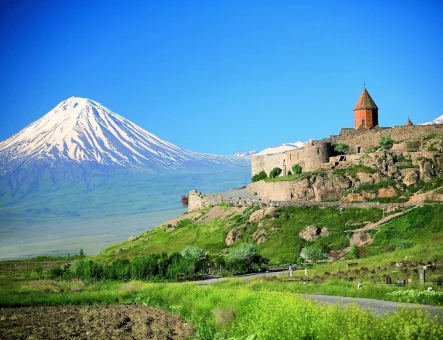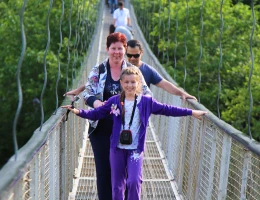Group tour:Khor Virap Monastery, Azat Reservoir, Garni Temple, Lavash baking master class, Geghard Monastery
Khor Virap Monastery, Azat reservoir view point, Lunch stop, Lavash baking master class, Garni Temple, Geghard Monastery
1. Khor Virap Monastery
50-60 min

Khor Virap is the most famous pilgrimage site in Armenia, as it is directly connected with the adoption of Christianity. As a state religion, Christianity in Armenia was adopted in 301 due to endeavors of Saint Gregory The Illuminator, who, before converting King Trdat The 3rd to Christianity, was imprisoned in the dungeon, over which a church of Khor Virap monastery was built in the 17th century. From the monastery one can admire the stunning view of the Biblical Mount Ararat.
2. Azat Reservoir
10-20 min

Azat Reservoir (1050 m above sea level) is located in Ararat province. It was put into operation in the year of 1976 with the aim of being used for irrigation of the Ararat Valley. The area makes 2.85 sq. km, while the total volume is 70 million cubic m. The reservoir is surrounded by mountains and within many years it has kept admiring visitors. The reflection of the Sun/Moon combined with clouds in water "spreads" a unique impression.
Lunch stop
50-60 min

Optional lunch in the local traditional restaurant on own expense. One may choose between 3 different options:
Option 1 (vegeterian) – 3900 AMD per person
Option 2 – 4500 AMD per person
Option 3 – 4900 AMD per person
Option 1 (vegeterian) – 3900 AMD per person
Option 2 – 4500 AMD per person
Option 3 – 4900 AMD per person
Lavash baking master class
15-20 min

As the saying goes: "Bread is the staff of life".
Lavash is one of the most popular gastronomic icons of Armenia, serving as an integral part of the Armenian cuisine. It is a traditional soft, thin flatbread, made in tonir (special ground oven). Although the baking process of lavash requires much of special skills, it is undertaken by women. For centuries lavash has been consumed by all classes of Armenian society, it is valued for the unique taste and the ability to be stored for quite a long period of time without losing its positive qualities.
In 2014 "The preparation, meaning and appearance of traditional bread lavash as an expression of Armenian culture" was inscribed in the UNESCO Representative List of the Intangible Cultural Heritage of Humanity.
During this master class you will observe and learn the millennia-old techniques of making lavash, and, of course, taste self-baked lavash together with some fresh greens and yummy local cheese. Feeling the smell of lavash once, you will save this impression for the whole life:)
Lavash is one of the most popular gastronomic icons of Armenia, serving as an integral part of the Armenian cuisine. It is a traditional soft, thin flatbread, made in tonir (special ground oven). Although the baking process of lavash requires much of special skills, it is undertaken by women. For centuries lavash has been consumed by all classes of Armenian society, it is valued for the unique taste and the ability to be stored for quite a long period of time without losing its positive qualities.
In 2014 "The preparation, meaning and appearance of traditional bread lavash as an expression of Armenian culture" was inscribed in the UNESCO Representative List of the Intangible Cultural Heritage of Humanity.
During this master class you will observe and learn the millennia-old techniques of making lavash, and, of course, taste self-baked lavash together with some fresh greens and yummy local cheese. Feeling the smell of lavash once, you will save this impression for the whole life:)
3. Garni Temple
60-70 min

Garni temple, which towers over a triangular cape, is the unique survived example of heathen culture in Armenia. It is a blend of Greco-Roman and Armenian styles. King Trdat The First ordered building the temple in the first century AD and dedicated it to the God of Sun. After adopting Christianity in 301, the pagan temple lost its significance and the fortress of Garni became the summer residence of the kings. Nowadays the ruins of the royal palace and the bathroom with a stunning mosaic work can be found near the temple.
4. Geghard Monastery
60-70 min

Geghard monastery is the unsurpassable masterpiece of the 13th century Armenian architecture. Some of the churches of the complex are masterfully hewn in a huge rock. From the outset the complex was called Ayrivank (cave monastery), later it was renamed Geghard (lance) as the lance, used by the roman soldier to sting Jesus Christ's side, had been kept in this monastery for many centuries. Due to its construction, Geghardavank serves the best place for singing spiritual songs. The complex is rich in subtle sculptural embellishments and many striking khachkars (cross-stones). The site is included in UNESCO World Cultural Heritage List.
Inclusions
- Professional guide: ENG + RUS consecutively
- Air-conditioned vehicles
- Bottled water & pastries
- Admission tickets
- Wi-Fi in the vehicles
- Vehicle & passengers insurance
- Master class & tasting
Exclusions
- Lunch cost (3 900 AMD – 4 900 AMD)
- Hotel drop-off after return to Yerevan
Highlights
- Embrace the stunning views of Biblical Mount Ararat
- Marvel at the one of a kind nature of Armenia from a special view point
- Explore the 1st century pagan temple
- Discover the legends of St. Lance used by the roman soldier to sting Jesus Christ's side
- Taste most delicious Armenian traditional bread
Frequently Asked Questions
Is there any distance to be carried on foot?
Yes, ~180 m walking (including climbing stairs) is required to reach Khor Virap Monastery, and also ~160 m to go up to Geghard Monastery.
Does Azat Reservoir look the same way as it is in photos?
The Azat Reservoir mainly looks the same as shown on the photos of our website, however, please, be informed, that it decreases in size during wintertime due to lower water levels.
How will you describe lavash baking master class? Can I take part in the lavash baking procedure?
As part of the experience, the lavash baking master class mainly demonstrates the traditional process of making Armenian bread, after which you'll get to enjoy it served with cheese and fresh herbs. If you have much initiative and are particularly eager to take part in the baking yourself, it's best to check with the tour guide in advance.
Can I pay for the lunch in the restaurant by card?
Not all restaurants accept cards, so it's best to have cash AMD on hand for lunch.
What is the group size for this tour?
The group size varies, but typically ranges up to 48 participants.
Are there any clothing requirements or recommendations for this tour?
We advise wearing comfortable footwear suitable for walking and dressing in layers, including a jacket or coat, as weather in the regions is typically cooler than in Yerevan. When entering churches or monasteries, women are requested to wear modest clothing and avoid anything too revealing as a mark of cultural respect.
Booking conditions
Cancellation & modification



